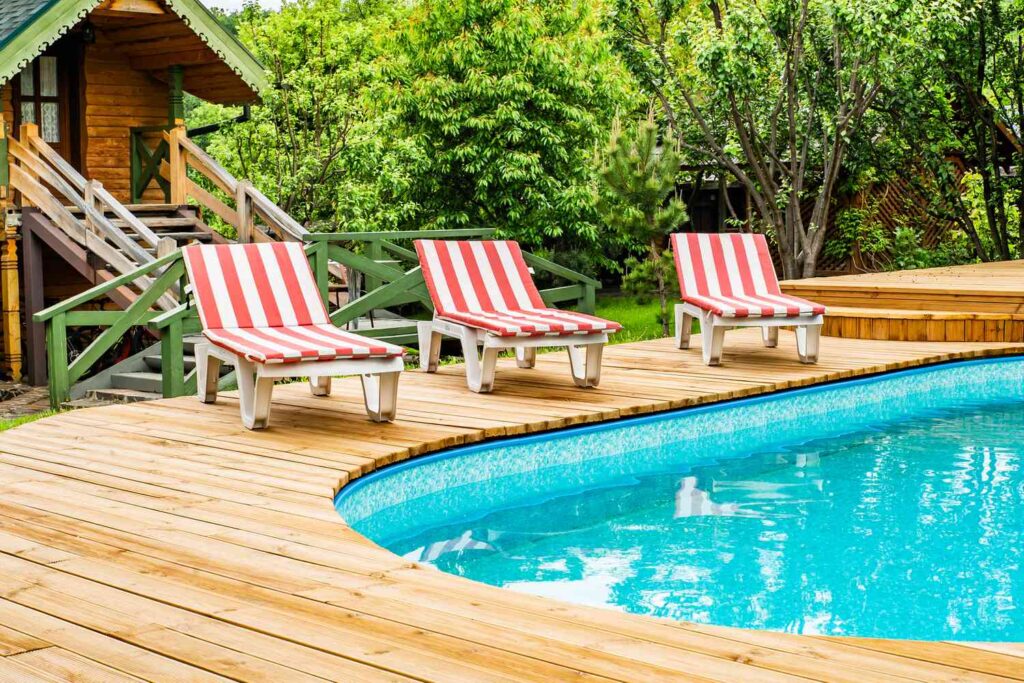20 Above Ground Pool Deck Ideas on a Budget

Above ground pools are a great way to enjoy backyard fun in the summer without breaking the bank. However, they can sometimes look a little out of place in the yard. Building a deck around your above ground pool can not only improve the aesthetics of your backyard but also create a functional and inviting space for entertaining and relaxation.
Here are some above ground pool deck ideas on a budget to get you inspired:
Simple Wood Deck
A simple wood deck is a classic and affordable option for above-ground pools. Pressure-treated lumber is a cost-effective choice that is readily available and relatively easy to work with. You can stain or paint your deck to match your desired aesthetic.
Benefits of a Simple Wood Deck:
- Cost-effective: Pressure-treated lumber is a relatively inexpensive material compared to composite decking or other alternatives.
- Easy to build: A simple wood deck design is suitable for DIY projects, especially for those with some basic carpentry skills.
- Versatile: A wood deck can be customized in size, shape, and stain color to fit your specific needs and preferences.
- Natural aesthetic: Wood decks offer a classic and natural look that complements most backyard landscapes.
Considerations for a Simple Wood Deck:
- Maintenance: Wood decks require regular cleaning and occasional staining or sealing to maintain their appearance and prevent rot.
- Longevity: While pressure-treated lumber is durable, it can deteriorate over time compared to some composite deck materials.
- Sun Exposure: Direct sunlight can cause wood decks to fade or crack over time. Consider applying a UV protectant stain for additional durability.
Building a Simple Wood Deck:
The specific steps for building a simple wood deck will vary depending on the size and design of your deck. However, here’s a general overview of the process:
- Plan and Design: Measure your pool and sketch out a deck design that considers access points, functionality, and desired size. Obtain any necessary permits from your local authorities.
- Prepare the Ground: Level the ground where you will be building the deck. You may need to remove sod or excavate depending on your soil conditions.
- Set the Posts: Install pressure-treated posts for the deck perimeter and any additional support beams needed. Ensure proper post depth and stability for weight-bearing capacity.
- Attach the Joists: Secure the joists (horizontal beams) to the deck posts using appropriate fasteners. Maintain consistent spacing between joists to support the deck surface.
- Install the Deck Boards: Attach the deck boards (planks) to the joists. Ensure proper spacing and alignment for a smooth walking surface.
- Finishing Touches: Add railings if desired, stain or paint the deck according to your preference, and apply any sealants for weather protection.
Tips for Saving Money on a Simple Wood Deck:
- Shop around for lumber: Compare prices at different lumberyards and consider pre-cut lumber options to save on time and potentially reduce waste.
- Utilize recycled materials: Explore using reclaimed wood or good-condition pallets for a portion of the deck structure (with proper sanding and preparation) to reduce costs.
- Focus on functionality: Prioritize creating a functional space with essential elements like a walking surface and access points. Elaborate features like built-in seating or fancy railings can be added later if your budget allows.
Multi-Level Deck
A multi-level deck can be a fantastic way to elevate (pun intended!) your above-ground pool area. It not only adds visual interest but also offers opportunities to create distinct functional zones in your backyard oasis. Here’s a closer look at this unique deck design:
Benefits of a Multi-Level Deck:
- Utilizes Slopes: If your backyard has a natural slope, a multi-level deck can seamlessly integrate with the existing landscape, maximizing usable space.
- Functional Zones: Different deck levels can create designated areas for lounging, dining, sunbathing, or even a poolside bar.
- Visual Appeal: The tiered structure adds a dynamic element to your pool area, making it more visually interesting than a flat deck.
- Hides Pool Support Structure: A multi-level design can cleverly conceal the above-ground pool’s support structure, creating a more polished and finished look.
Considerations for a Multi-Level Deck:
- Complexity: Building a multi-level deck requires more planning and construction expertise compared to a simple deck. Consider your DIY skills or consult a professional for a safe and structurally sound design.
- Building Codes: Ensure your multi-level deck adheres to local building codes regarding railing heights, stair construction, and overall weight capacity.
- Accessibility: Incorporate stairs or ramps with proper handrails for safe and easy access between different deck levels, especially for children or elderly users.
Design Ideas for a Multi-Level Deck:
- Two-Level Design: A popular option is a two-level deck with one level surrounding the pool and a higher level serving as a dedicated lounging or dining area.
- Split-Level Design: This design creates separate activity areas on different levels, catering to diverse needs. Imagine a sunbathing platform on one level and a shaded dining area on another.
- Decked Entryway: Elevate the pool entry point with a few deck steps, adding a touch of grandeur and separation from the rest of the yard.
- Water Feature Integration: Create a cascading waterfall or a small koi pond on a lower level, adding a beautiful water element to your multi-level deck.
Building a Multi-Level Deck:
The construction process for a multi-level deck is more involved than a simple deck. Here’s a simplified breakdown:
- Detailed Planning: Create a detailed plan with precise measurements and elevation changes for each level. Ensure your design complies with local building codes.
- Foundation and Support: Construct a sturdy foundation system using pressure-treated lumber or concrete piers to support the weight of the multi-level structure.
- Building Each Level: Follow the general deck building process (setting posts, attaching joists, and installing deck boards) for each individual level.
- Stairs and Railings: Install safe and code-compliant stairs with proper handrails for access between levels. Railings are also required around the perimeter of each deck level.
- Finishing Touches: Stain or paint the deck to match your desired aesthetic and add any finishing elements like built-in seating or planters.
Tips for Saving Money on a Multi-Level Deck:
- Seek Free Deck Plans: Numerous online resources offer free multi-level deck plans specifically designed for above-ground pools. Utilize these for inspiration and guidance.
- Stage the Construction: Consider building the deck in phases. Start with a basic single-level platform around the pool and add additional levels later as your budget allows.
- Prioritize Functionality: Focus on creating essential functional areas on the initial level and consider adding decorative elements like planters or lighting in the future.
Pallet Deck
Pallet decks are a fantastic way to add a touch of rustic charm and functionality to your above-ground pool area, all on a shoestring budget. Here’s a deep dive into the world of pallet decks, exploring their pros and cons, construction steps, and money-saving tips.
Benefits of a Pallet Deck:
- Super Budget-Friendly: Pallets can be free or very inexpensive, making them a perfect choice for cost-conscious DIY enthusiasts.
- Eco-Friendly: Repurposing used pallets reduces waste and gives them a new life, contributing to a sustainable approach.
- Unique Aesthetic: Pallet decks offer a warm, rustic look that complements natural landscapes and creates a relaxed outdoor vibe.
- Easy Customization: Pallets can be arranged in various configurations to suit your desired deck size and shape.
Considerations for a Pallet Deck:
- Pallet Quality: Not all pallets are created equal. Choose sturdy, heat-treated pallets (marked “HT”) that are free of splinters, nails protruding from the surface, and any signs of rot or damage.
- Disassembly and Preparation: Disassembling pallets and sanding down rough edges is crucial for a safe and splinter-free deck surface. Wear gloves and safety glasses during this process.
- Limited Lifespan: Pallet wood, although sturdy, might not be as durable as pressure-treated lumber. Be prepared for potential warping or deterioration over time, and plan for repairs or replacement as needed.
Building a Pallet Deck:
Here’s a simplified outline for building a pallet deck around your above-ground pool:
- Plan and Design: Measure your pool and sketch a deck layout considering access points and desired size. Remember, pallet sizes are standard, so factor that into your design.
- Gather Materials: Source free or inexpensive pallets, ensuring they meet quality standards. You’ll also need deck screws, fasteners, weed barrier fabric (optional), and tools like a hammer, saw, and drill.
- Prepare the Pallet Wood: Disassemble the pallets carefully, removing any loose nails or staples. Sand down the wood surfaces thoroughly to remove splinters and create a smooth finish.
- Level the Ground: Ensure the ground where your deck will be built is level. You might need to remove sod or add gravel for proper drainage.
- Lay the Foundation (Optional): Consider using landscape timbers or concrete pavers to create a stable base for your pallet deck, especially if the ground is uneven.
- Build the Deck Frame: Use sturdy beams or additional pallet wood to create the perimeter frame of your deck. Secure the frame with deck screws.
- Arrange the Pallet Deck Surface: Lay the prepared pallet boards on the frame, ensuring a level and stable surface. You can arrange them in a straight pattern, herringbone style, or other creative configurations. Secure the pallets to the frame using deck screws.
- Finishing Touches: Add railings for safety, especially if your deck is elevated. You can also stain or paint the pallet deck for a desired aesthetic.
Tips for Saving Money on a Pallet Deck:
- Hunt for Free Pallets: Check with local businesses, recycling centers, or online platforms offering free pallets. Be prepared to pick them up yourself.
- Focus on Functionality: Prioritize creating a basic walking surface around the pool. Additional features like built-in benches or planters can be added later as your budget allows.
- Repurpose Old Materials: Utilize leftover lumber or scrap wood for railings or support beams instead of buying new materials.
Pea Gravel
Pea gravel offers a simple, cost-effective, and low-maintenance solution for creating a functional and attractive area around your above-ground pool. Here’s a closer look at the benefits, considerations, and installation process for using pea gravel for your pool deck.
Benefits of Pea Gravel:
- Budget-Friendly: Pea gravel is a very affordable material compared to building a traditional deck or patio.
- Easy to Install: Creating a pea gravel patio requires minimal construction skills and can be completed in a weekend.
- Low Maintenance: Pea gravel requires minimal upkeep compared to wooden decks or concrete patios. Regular raking and occasional weed control are sufficient.
- Good Drainage: Pea gravel allows for good water drainage, preventing mud buildup and potential mosquito breeding grounds around your pool.
- Comfortable on Bare Feet: Pea gravel provides a comfortable walking surface that feels cool and pleasant on bare feet, especially on hot summer days.
Considerations for Pea Gravel:
- Not a Walking Surface for Everyone: While comfortable on bare feet, pea gravel can be uncomfortable for walking in shoes with thin soles. Consider creating designated walking paths with stepping stones or pavers if desired.
- Can Be Messy: Pea gravel can track into your house more easily compared to a solid deck surface. Place mats or designated cleaning areas near pool access points.
- May Not Be Ideal for All Climates: In areas with harsh winters, pea gravel can freeze and become slippery. Consider alternative materials if your winters are severe.
Installing a Pea Gravel Patio Around Your Above-Ground Pool:
Here’s a breakdown of the steps involved in installing a pea gravel patio:
- Measure and Mark the Area: Measure the desired perimeter around your pool and mark the boundaries with spray paint or landscaping edging.
- Excavate the Area (Optional): For improved drainage and a more defined edge, consider excavating a shallow trench around the pool perimeter, typically 4-6 inches deep. This step is optional but recommended.
- Lay Down Landscape Fabric: Install a weed barrier fabric throughout the designated area to suppress weed growth and prevent pea gravel from mixing with the soil below. Secure the fabric with landscape staples.
- Add a Base Layer (Optional): For better stability and weed prevention, consider adding a 2-inch layer of crushed gravel over the weed barrier fabric. This layer allows for better drainage and provides a more solid foundation for the pea gravel.
- Install Edging (Optional): While not essential, installing edging around the perimeter helps contain the pea gravel and creates a more finished look. You can use plastic edging, metal edging, or even natural stones.
- Spread the Pea Gravel: Pour the pea gravel evenly over the entire area, ensuring a consistent depth of 2-3 inches. Aim for a slightly sloped surface away from the pool for proper drainage.
- Compact and Level the Gravel: Use a tamper or a flat board to gently compact and level the pea gravel surface.
- Finishing Touches: Add decorative elements like stepping stones, potted plants, or outdoor furniture to personalize your poolside area.
Tips for Maintaining a Pea Gravel Patio:
- Regular Raking: Rake the pea gravel surface periodically to maintain a smooth and even distribution, preventing ruts or uneven areas.
- Top Up the Gravel: Over time, pea gravel can get displaced or lose volume. Top up the gravel as needed to maintain the desired depth and prevent the weed barrier from becoming exposed.
- Weed Control: Even with weed barrier fabric, occasional weeds might pop up. Remove them promptly to prevent them from spreading. Spot application of weed control products can be helpful.
Other Tips for Saving Money on Your Above Ground Pool Deck
- Shop around for materials. Get quotes from several different lumberyards before you make a purchase.
- Consider building your deck yourself. If you are handy, you can save money by building your own deck. However, be sure to do your research and make sure you have the necessary skills and tools before you get started.
- Reuse materials. If you have any leftover lumber from other projects, you can use it to build your deck.
- Skip the fancy extras. You don’t need to spend a lot of money on bells and whistles for your deck. A simple deck can be just as functional and enjoyable as a more elaborate one.
With a little creativity and planning, you can build a beautiful and functional deck around your above ground pool without breaking the bank.
Here are some commonly asked questions:
- What are the most affordable materials for an above-ground pool deck?
Pressure-treated lumber is a cost-effective and readily available option. You can also explore recycled materials like pallets (with proper sanding and preparation) for significant savings. Consider alternative deck surfaces like pea gravel for a low-maintenance, budget-friendly solution.
- Can I build my own above-ground pool deck to save money?
Yes, building your own deck can be a cost-effective option, especially if you’re handy and have the necessary tools. However, ensure you have the skills and knowledge for safe construction. Consider your DIY experience and project complexity before making a decision.
-
What are some tips for saving money on my above-ground pool deck?
-
Shop around for materials: Compare prices at lumberyards and consider pre-cut lumber options for easier construction.
-
Reuse materials: Utilize leftover lumber from other projects or explore used, good-condition pallets for a budget deck base.
-
Prioritize functionality over fancy features: Focus on creating a functional space with essential elements. Elaborate railings or lighting can be added later as your budget allows.
-
Consider alternative deck designs: Explore options like a simple platform deck or a multi-level deck that utilizes your existing backyard slope, potentially reducing overall material needs.
-
What are some resources to help me plan and build my above-ground pool deck?
Many online resources offer free deck plans, tutorials, and cost calculators specifically designed for above-ground pool decks. Utilize these resources to determine the materials needed, estimate costs, and gain construction guidance.



